Hi guys, how’s it going? This is 2021 and now you’ve decided to buy a sewing machine, so you need to be careful. There’re lots of fabric sewing machines available on the market. But even the best sewing machine for thick fabric manufacturers have their fair share of crap machines.
I’m not joking here, 99% of sewing machines are released by the top manufacturers in the USA but it doesn’t make it to the top list. Welcome to our website buyer’s guide for sewing machines.
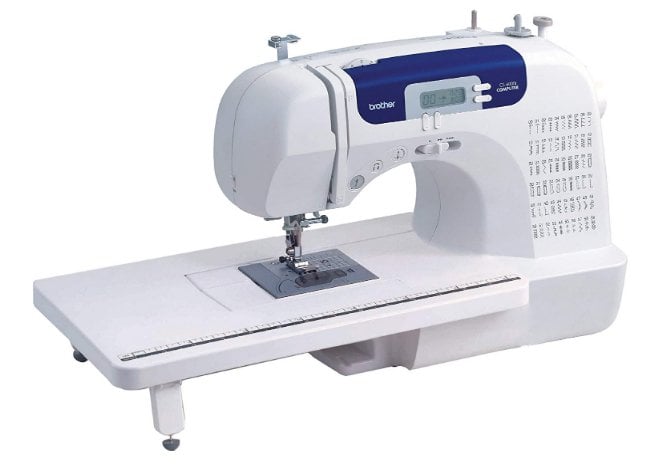
We Spent 9 Days to select 10 sewing machines for thick fabric. So, if you’re searching for a good quality sewing machine for sewing thick fabrics, please read the full content & pick one from our list.
A machine helps your own gives you a creative and practical way to make your own design on your clothes. It’s also great for making crafts, windows, and bedding. And today’s technology help you get a machine customized to your needs is endless.
Contents
- Top 5 Best Sewing Machine for Heavy Fabrics
- 10 Best Sewing Machine for Thick Fabrics Reviews
- 1. Janome 2212 Sewing Machine Includes Exclusive Bonus Bundle
- 2. Singer 4423, Best Heavy Duty Sewing Machine for Thick Fabrics
- 3. Brother CS6000i Sewing Machine
- 4. Singer 7258 100-Stitch Best Computerized Sewing Machine for Thick Fabric
- 5. Brother XR9550PRW Computerized Sewing Machine for Heavy Fabrics
- 6. Singer Quantum Stylist 9960 Best Portable Sewing Machine for Fabric, Leather, Canvas
- 7. Brother XM2701 Best Lightweight Sewing Machine
- 8. Juki HZL-F600 Computerized Sewing Machine
- 9. Brother HC1850 Sewing Machine for Thick Materials
- 10. Brother SE400 Best Embroidery Computerized Sewing Machine
- What is a Sewing Machine?
- What are The Best Sewing Machines on The Market?
- Which Sewing Machine is Better?
- How to Use a Sewing Machine
- The Most Popular Brands
- What Should I Know Before Buying a Cheap sewing Machine for The Money?
- Tips for Buying The Best Singer Sewing Machine
- How Does a Sewing Machine Work?
- How to Use a Sewing Machine?
- Look for the Power Button:
- Locate the Spool Holder:
- Find the Thread Guide:
- Look for he Bobbin Winder:
- Locate The Stitch Adjustment Buttons:
- Locate The Thread Strip Lever:
- Find the Thread Tension Regulator:
- Look for The Needle Adjustment Screw:
- Look for The Presser Foot:
- Install The Needle Securely:
- Roll up and Insert The Bobbin:
- Thread The Sewing Machine:
- Remove Both Threads:
- Plug in The Machine and Turn it on:
- Bring the presser foot closer to the fabric:
- Hold the loose ends of both threads:
- Press The Pedal:
- Where to Buy a Sewing Machine?
- Frequently asked Questions
- Conclusion
Top 5 Best Sewing Machine for Heavy Fabrics
- Singer Heavy Duty 4423 Sewing Machine
- Janome 2212 Sewing Machine
- Brother CS000i Sewing Machine
- Singer 100-Stitch Computerized Sewing Machine
- Brother Computerized Sewing Machine
Here is our buying guide that the 10 sewing machines for thick fabric options you should consider.
10 Best Sewing Machine for Thick Fabrics Reviews
- Janome 2212 Sewing Machine
- Singer 4423, Best Heavy Duty Sewing Machine
- Brother CS6000i sewing machine
- singer 7258 computerized sewing machine
- Brother computerized sewing machine
- Singer Quantum 9960 portable sewing machine
- Brother XM2701 sewing machine
- Juki HZL-F600 sewing machine
- Brother HC1850 sewing machine
- Brother SE400 Embroidery Sewing Machine
Finally, we’ve our section that dives right into our picks for the best fabric sewing machine of 2021. We are describing brand reputation, consumer reviews, Price vs product quality, and features.
We always try to describe a decent variety into our buyer’s guides so that you’re likely to find a sewing machine that best fits your needs.
After this section, you’ll find some tips that you’re looking for the best fabric sewing machines for beginners VS. more experienced sewers.
1. Janome 2212 Sewing Machine Includes Exclusive Bonus Bundle
The Janome 2212 is a simple sewing machine that is a quality entry-level model and fantastic price.
These features 12 built-in stitches, easy to four-step buttonhole, dial pattern section, and zig-zag stitch width adjustment that ensure each of use.
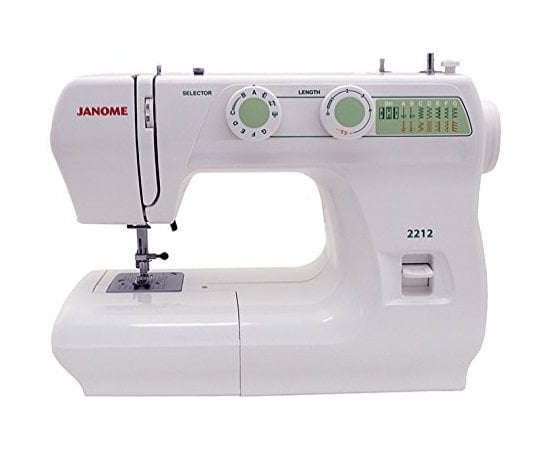
The Janome 2212 has great features which like a free arm and drop feed that makes the machine versatile for all types of sewing. These are lightweight and very durable.
The mechanical sewing machine is a stitch quality and it can sew through anything you throw at it. This machine is easy to use and affordable price.
This machine has built-in top quality and doesn’t doubt durability. The old mechanical sewing machine lowers will love it because it seems like one from the classical singer era. This machine is perfect for a beginner and the right product.
Pros:
- Stitch quality
- Mechanical machine
- Smooth operation and durability
- Use four-step buttonhole
- Perfect for beginner
Cons:
- Sometimes missing beginner-friendly features
- Expensive parts to replace when broken
Read Next: Electric scissors for cutting fabric
2. Singer 4423, Best Heavy Duty Sewing Machine for Thick Fabrics
The Singer heavy-duty 4423 is the second on our list of top 22 that is considered to be one of the best heavy duty sewing machine for thick fabrics and leather.
This machine has 23 built-in stitches and it allows you to complete different projects. Most of the sewers like Janome’s heavy-duty sewing machine because it comes with an automatic needle threader.
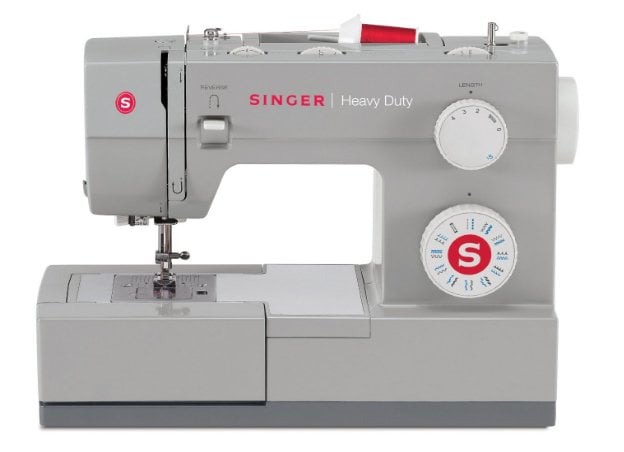
This is an important feature that we didn’t mention before it will reduce your eye pain, cut frustration and boost your mood before sewing.
The singer is a high-speed sewing machine. We mentioned that it’s not important for fast sewing but it’s more important for adjustable speed control. They’ve 60% stronger motors than the other sewing machine on the list.
The singer is heavy duty is made from a metal frame and comes with different free accessories such as button sewing foot, needles, bobbins, foot purpose, zipper foot, and 25-years warranty. And this machine has more outstanding customer reviews on Amazon.
Pros:
- The singer is high sewing speed that you get to work faster.
- It comes with a variety of decorative stitches
- It comes with 23 built-in stitches
- Automatic needle threader
- 25-years satisfaction warranty
Cons:
- No light-up is included
- Hard to follow instructions but heavy duty
Read Next: 10 fabric cutting scissors
3. Brother CS6000i Sewing Machine
The Brother CS6000i sewing machine is the top number brand on the market. They’ve more advanced features that deliver some of the great sewing experiences ever.
It’s a very convenient machine and easy to use. We know it’s an excellent option for long time use.
This machine comes with all the features that are very necessary for each use for a green sewing learner.

It gives us the outstanding performance and works well for an experienced tailor too.
It’s a versatile machine that is very resourceful. If you want to be kick off your tailoring sessions with a bang, you need to be the sewing machine for you.
This machine seems like a great sewing machine. These are not been called into any question on any platform. There’re a few complaints about the frame that is made of plastic. Ultimately, it depends on you can maintain your sewing machine.
Overall, the sewing machine has a few features that are important. They have an excellent option for the beginner, anyone, or veteran.
Pros:
- It comes with 60 built-in stitches
- This machine is equipped with an LCD screen
- Adjustable sewing speed
- It comes with a large table that allows a long space for your work
- The machine is easy to operate.
Cons:
- The machine made of the plastic frame.
Read Next: 10 fabric rotary cutters
4. Singer 7258 100-Stitch Best Computerized Sewing Machine for Thick Fabric
If you find out the sewing machine there, you’d not be disappointed with the singer 7258 computerized sewing machine.
These are top-rated sewing machine for thick fabrics that comes from a well-known brand and it’s very functionally that all are a reasonable price.
The sewing machine comes programmed with 100 different stitches, 76 decoratives, nine basics, eight stretch, and seven built-in buttonholes. This stitch is as easy as pressing a button.
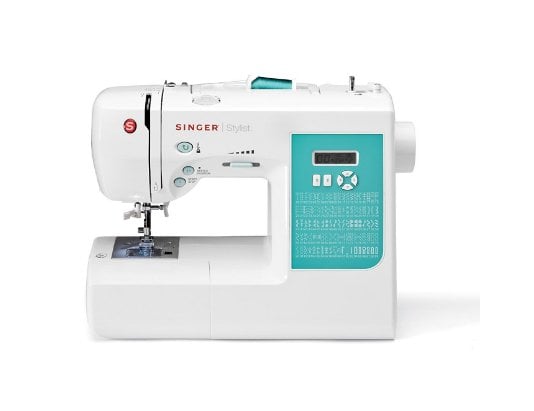
You can be preselected for the optimal length and width, though you can customize them if you want. The singer 7258 has a built-in easy load bobbin system, programmable needle position, needle threader, LED light, snap-on presser feet, twin needle capacity, and more.
The singer 7258 100-stitch comes with a variety of accessories like zipper foot, seam ripper, blind hem foot, darning plate, and many more things.
This machine is also impressively versatile and saying it’s heavy-duty and easy to use. It’s a great choice for both advanced and beginners crafters. So you can’t beat it in terms of value.
Pros:
- This machine has a high sewing speed, you can get work faster
- This is a computerized sewing machine which makes it easy to set up
- Included LED bulb that lights up the workspace.
- The bobbin cover is clear
- The machine has an LCD display panel
Cons:
- The reverse button works slow response
- This machine initial set upsetting may be challenging
5. Brother XR9550PRW Computerized Sewing Machine for Heavy Fabrics
If you find another high-tech computerized sewing machine that is super easy to use work faster and save your time, you need to attend is the Brother XR9550PRW. It’s perfect for advanced and beginners crafters.
This machine is capable of completing runway-ready garments and you can do the work cheap and simple.
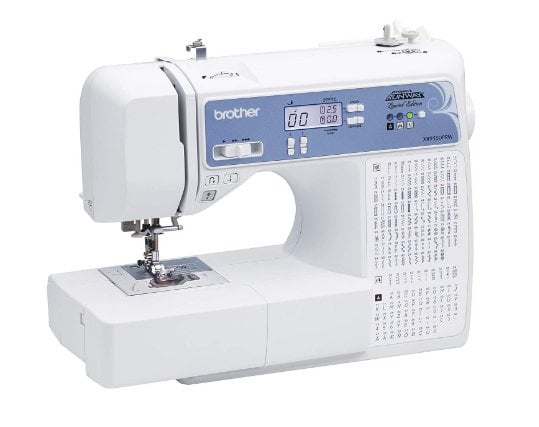
It comes with 165 built-in stitches, included 8 buttonholes, a long bobbin for workspace, and adjustable speed. This model gets with various feet and accessories.
This model included a hardcover case for protection and a large work table for finishing larger projects. Keep in mind that every sewing machine has positive and negatives sides but don’t worry because it’s a satisfaction warranty and this one is not an exception.
Pros:
- Highly speed and adjustable
- Perfect for beginner
- Very durable and affordable price
- It comes with various feet and accessories
- Choose from 8 styles of one-step and auto-size button holes
Cons:
- Lack of accessories
- Limited edition
6. Singer Quantum Stylist 9960 Best Portable Sewing Machine for Fabric, Leather, Canvas
If you’re looking portable computerized sewing machine, Singer Quantum 9960 is perfect for you.
It has a lot of features that will help you finish the most complicated customized projects and is easy to use.
When used this Singer Quantum stylist 9960 sewing machine will make your sewing dreams come true and get a good sewing experience.
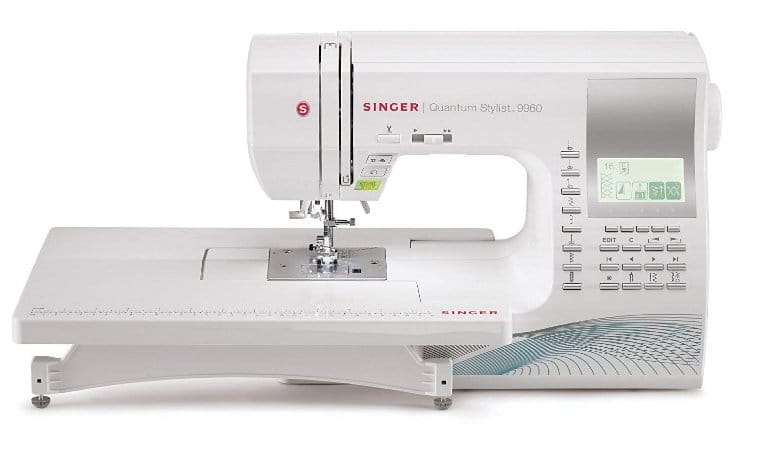
It’s a high-speed and heavy-duty sewing machine for fabric, leather, canvas, and others. It comes with 600 built-in stitches that you can use with a touch of a button.
The sewing machine’s sewing speed with a maximum speed of 850 stitches per minute. However, keep in mind that speed is not the main feature of a sewing machine.
The most important feature that one adjustable speed control that doesn’t happen to be the case with this sewing machine.
It comes with free accessories like button sewing foot, open toe foot, zipper foot, buttonhole foot, and others.
Keep in mind that, the machine is designed for Canada and the USA use only. So it’s one of the biggest disadvantages for a workhorse.
Pros:
- Automatic needle threader
- Workhorse
- 600 built-in stitches
- Multifunctional sewing machine
- The maximum speed of 850 stitches
Cons:
- Made for using Canada and USA only
- No adjustable speed control
7. Brother XM2701 Best Lightweight Sewing Machine
The Brother XM2701 lightweight sewing machine is on the top list as the sewing machine for beginners.
It’s small and lightweight. And reasonable price under $100. It comes with an instructional DVD and light.
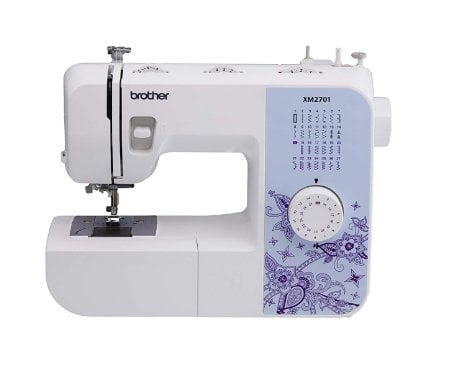
There’re thousands of reviews and like the ease of use and versatility of the machine.
The Brother XM2701 is a compact sewing machine that comes with 27 built-in stitches, decorative, including blind hem and quilting options.
It included a one-step button-holer and LED light that easier to see what you’re doing. This machine is all about ease of use, automatic needle threader, easy threading system, and jam-resistant drop-in bobbin.
It comes with 6 quick-change sewing feet and the customer says it’s a great option for beginners or lives in a small space.
They have a foot pedal that’s not easy to control with the foot pedal. This machine might wear out quicker than other machines and be higher-quality.
Pros:
- Maximum sewing speed 800 stitches per minute
- 27 unique built-in stitches
- perfect for a wide range of everyday sewing projects
- 6 quick-change sewing feet
- 25 years limited warranty
Cons:
- No adjustable speed control
8. Juki HZL-F600 Computerized Sewing Machine
The Juki HZL-F600 computerized sewing machine is the latest technology. This machine is fully computerized and its many features which the perfect sewing experience possible.
They’ve many features that all systems are automated. The sewing machine comes with great convenience and each operation and it works well.
This machine has some features that you’re going for buying if you’re looking to start a sewing business.
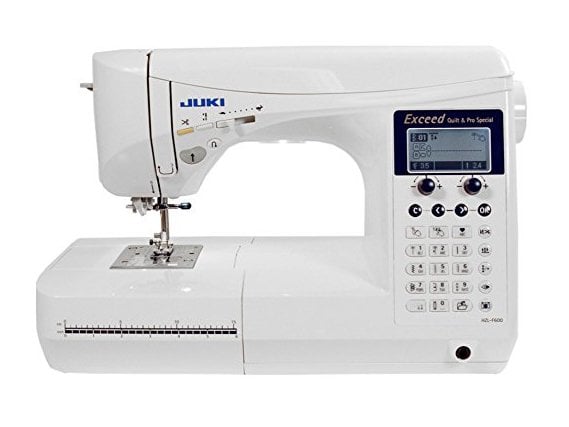
They come with an extendable sewing table and use box-feeding technology. When using it they give us free-motion sewing.
The Juki HZL-F600 delivers excellent convenience. If you change the initial setting, you’ll enjoy a superb sewing experience.
However, it’s automation, so saves you a lot of trouble that comes with setting up this machine. These are a variety of stitches and many other features that are very impressive and engages your creative sense fully.
They’re a world classic sewing machine which quilting and regular sewing. They’ve maximum reviews on Amazon that are overwhelmingly positive too.
Pros:
- They’ve an extendable table that help us enough workspace
- This machine fitted for LCD screen
- All features are functionally and fully computerized
- They’re lightweight and portable
- The sewing machine has a top speed of 900-stitches per minute
Cons:
- The computerized systems require initial setting before start sewing
- Sometimes jumping the sewing machine
9. Brother HC1850 Sewing Machine for Thick Materials
If you’re looking for an upgrade computerized quilting machine, the Brother HC1850 is ideal for you. You can expect excellent services on this machine.
It comes with some sophisticated and exciting features of the sewing machine. The Brother HC1850 is a very stitching enthusiast and resourceful sewing machine.
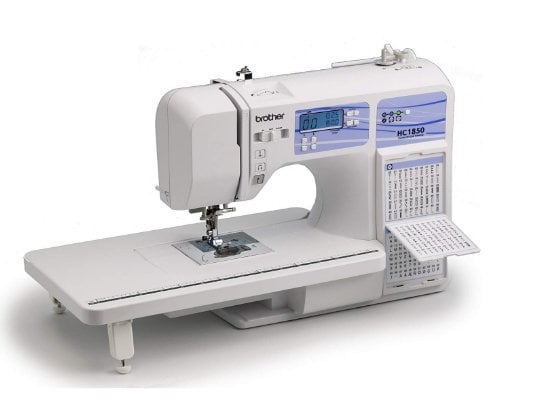
It’s a computerized and fully automated machine. We know you can enjoy using this machine and gives the perfect sewing experience.
They’re an excellent reputation for this brand of sewing machine. This sewing machine is a top of the range and they’re arguably the high-quality sewing machine. There’s an excellent option and use for commercial applications. It comes with many impressive features and enviable performance.
The machine has 130 stitches sewing speed per minute that are adjustable sewing speed. It’s fitted for LCD backlight for table and extensive working table included. Overall, this is another best sewing machine for heavy fabrics on our list.
Pros:
- It has a wide stitch variety
- It fitted and set up automated that will save a lot of energy
- It delivers good sewing speed
- Easy to select stitches and buttonholes with LCD panel
- The machine comes with DVD guide and very handy
Cons:
- This machine chassis made with plastic
10. Brother SE400 Best Embroidery Computerized Sewing Machine
The Brother SE-400 embroidery machine comes in to further cement the position of the sewing machines.
This machine is not using only stitching but also using embroidery. They have an excellent reputation for the Brother sewing machines.
Embroidery is a big part of the tailor and any serious tailor uses the machine in their hands. This machine comes with numerous features that will work well.
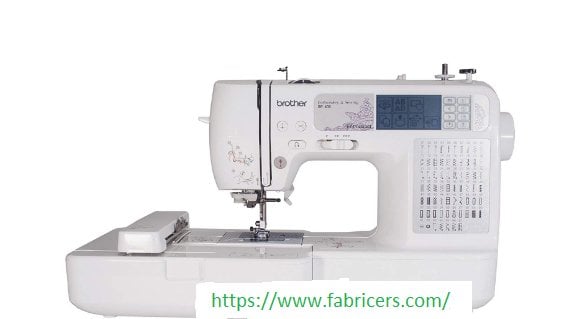
These are beautiful and affordable. The SE-400 are a full range of sewing features and is budget-friendly. It helps us create the ability to embellish home décor.
The beginner and advanced sewers alike and enjoy the sewing features that including 67 sewing stitches with 98 stitch functions.
They have an LCD light screen display, a built-in tutorial, and get a quick start guide.
Pros:
- The sewing machine is fully automated systems
- LCD touchscreen display
- It fitted for seven feed dogs
- They give us easy bobbin preparation and smooth fabric feeding
- The LED bulb provides sufficient light for your workspace
Cons:
- This machine made of a plastic frame
What is a Sewing Machine?
A sewing machine is, as the name implies, a machine or mechanism that allows sewing or joining textile material with thread.
The main components that allow a sewing machine to fulfill its function are the motor, the spinning system, and one or more needles. In this way, they can perform sewing at incredible speeds and with great ease.
Today there are both mechanical and electronic sewing machines on the market. The next section will be dedicated to explaining the different types that exist of each of these two modalities, and what are the advantages and disadvantages of using each of them.
In short, a top-quality sewing machine for quilting is a source of almost inexhaustible possibilities: with it, you can from fixing clothes, sewing simple tears or fraying, to creating your own textile designs.
What are The Best Sewing Machines on The Market?
If you’ve decided to read this guide to buy the cheap sewing machine for fabrics or leathers, it’s because you know that taking a minute of your time doing, so can prevent you from making a bad choice.
Whether it’s the first time you touch a sewing machine or you’re the family’s expert, there’re many factors to consider:
Which Sewing Machine is Better?
When you decide to buy a fabric sewing machine, you have to choose one that gives you what you need; It’s an investment that will affect the quality of the work you do in it and the possibility of doing more and more projects for your home and your family.
Features
First, it would be important to have a machine with sufficient drag power. This will depend on the type of work to be done and the type of fabric that you want to sew.
For fabrics and normal work, a machine with about 75 W of power will be sufficient. Some of the most important characteristics to evaluate when buying a machine are:
Types of Stitches:
The variety is very wide, some machines have only basic stitches, while others offer dozens of possibilities.
If you only have simple stitches, you can make arrangements or make simple things, but if you want something more decorative or worked, a sewing machine for kids that offers a greater variety of stitches is better.
It would be advisable that, in addition to the straight point, it has a zig-zag, invisible point, and elastic point. It also values that the width and length of the stitches can be varied.
Thread Tension:
Preferably choose a machine that allows you to adjust the thread tension manually. Letting the machine automatically adjust the tension is the simplest, but not always the most appropriate.
Presser Foot:
Almost all machines offer the possibility of using interchangeable presser feet, some of them to perform special functions such as eyelets. It’s also important the possibility of placing double height, to use it with thicker fabrics.
Other Features:
Depending on the type of projects you’re going to do, you’ll need a more or less robust machine. Even if you like for example making bedspreads, quilts, curtains for indoor or outdoor, it would be important to choose a machine that allows you to handle those volumes of fabric, even with an extendable table and something quite fast.
Finally, not always sewing machine for making clothes that have many functions is the best, it may not be for you.
If the user that you’re going to give it’s very basic, it’s not worth investing a lot of money in a machine with functions that you’ll never use, it could even be that the amount of controls demotivates or confuses you or on the contrary. If you love sewing or you’re fully involved in making crafts that require using the machine, don’t hesitate and buy a more complete machine.
Design
With regard to the design of the machine, take into account if you’re going to need to move it from one place to another in which case you should look for it to be light or if you’re going to have it fixed in which case you can opt for a more advanced one even with a piece of furniture.
Be careful with machines that are too light, it could be because it has many plastic parts in its gear.
However, well-known brands usually offer products made with quality material, so it’s great to choose one of them. To facilitate transport safely, some machines come with a built-in handle or with a case, this will also protect your investment when it’s not being used.
Another element of the design that’s valuable is the fact that it has a free arm. If you’ve it, it will be easier to make seams of a tubular type such as sleeves or cuffs.
Accessories
When you make the comparison of machines, keep in mind that some have a lower price but don’t include or include few accessories and then you’ll have to buy them, if you get them, apart. different presser foot for eyelets, double stitching, needles, tools for basic maintenance and cleaning.
Versatility
When deciding which machine to buy, you should keep in mind the type of work you want to do with your machine.
If you’re going to use it only in a couple of occasional patches, a simple machine will suffice, but if for example, you’re going to work with thick fabrics or make quilts, you’ll need a more powerful machine.
If your budget allows you to buy a machine with more advanced features, don’t hesitate to do so because it’s very likely that once you start seeing your ready-made projects you no longer want to stop.
How to Use a Sewing Machine
A sewing machine is always useful in any home. It can be used to repair, adjust, make. There’re many uses and applications that can be given, as long as you take it out of the closet and start using it.
In this article, you’ll find some recommendations to know how to use the sewing machine.
Read The Instruction Manual
To use the sewing machine, first of all, you should read the instructions, they can obtain all the information regarding the use and care of the machine.
Even if you’re an expert in sewing, don’t use the machine without first reading the instructions, since not all machines, models, and brands work in the same way.
Get Familiar with Your Fabric Sewing Machine
It’s important to get acquainted with the sewing machine and know how to turn it on, how the stitches are chosen, how it’s threading, how the thread is placed … in short everything concerning the activities that are usually done with the machine.
If something doesn’t work out or doesn’t work as expected, you should resort to the instruction manual and confirm that things are being done according to the instructions.
Multiple Functions
As stated earlier, the machines, models, and brands may be different, therefore it’s convenient that you pay special attention to the functions that your machine has.
This will depend on the type of work that can be done on the machine, therefore you should know well the functions you have.
Types of Stitches
The types of stitches are also extremely important, as these have to do with the type of seams that can be made on the machine;
It will also depend on what work can be done with the machine, as certain types of work and terminations require special stitches.
The Automatic Needle Threading System
If the machine has this system, it has a great advantage, since there’s a lot of time that is usually wasted while threading the machine needle.
If your machine has this system, don’t hesitate to use it; use it again and again until it’s a routine activity, and do it every time you need it.
Keep it in an Easily Accessible Place
It’s important to consider the place where the sewing machine will be held. The ideal is to have it in an accessible place, where it can be easily used when you need it or want to start a project.
If you have it in a place where it can’t be easily used, it’s most likely never used or almost never.
Start at The Beginner
This will seem obvious to you, but many times we ignore some basic aspects and intend to pass the most complex at once. Start with the most basic aspects, functions, or jobs;
As you progress in sewing and in the most basic projects, continue towards the most complex, believe me, you’ll be surprised by the results.
Don’t be Afraid to Use Your Sewing Machine
Use your machine without fear, don’t underestimate or waste the opportunity of any job.
Something as common as a ring or solving a small ripping in a garment can be easier and faster if you do it with the sewing machine
The Most Popular Brands
For those customers who enjoy sewing and want to acquire a machine for it but don’t know how to choose one in particular, because they don’t know the quality standards of each of them, we conducted a survey among customers that threw us three brands that they stand out for their preference: Singer, Brother, and Alfa.
It’s a company that was founded in 1851 by Isaac Merrit Singer, with a lawyer named Eduard S. Clark, under the name of IM Singer & Co.
Since its inception, it became known with great enthusiasm as machine-producers sewing. In 1865 he changed his name to Singer Manufacturing Company, then renamed in 1963, with the name The Singer Company.
In the beginning, this company produced everything in New York City and then moved to Tennessee. In the year 1858, he made his first sale in Brazil, and then in the year 1876 attend the international fair of Philadelphia making his product known.
Singer, in order to satisfy its customers, has created a web page where it offers different options such as the freedom to choose the region in which you’re, where after selecting it you’ll be able to visualize the whole range of articles and accessories that this Company in that area. Its base product stands out here, which are sewing machines for all uses such as domestic sewing, domestic embroidery, and industrial sewing.
As well as each of the accessories necessary for proper use such as needles of different sizes and open-toed, closed-toe shoes, among others.
This is an Argentine corporation that has 100% proprietary technology, which is why it’s already known worldwide with 20 factories in more than 34 subsidiaries.
However, it has its matrix in Nagoya, Japan. Its foundation was produced in 1908 offering its clientele a lot of variety, advanced articles and quality recognized throughout the world. The company has three divisions where the same quality that characterizes this company is maintained, such as industrial machines, for manufacturing and metallurgical industries.
The creators of Brother are characterized by developing products of high creativity, not only for personal use, but also for industrial, bringing great results to their customers.
Among its most prominent products are sewing machines of different models to satisfy all its customers, electronic sewing machines, small, portable, high-quality labeling machines, with the ability to withstand heat and not detach.
It also has innovative office products in order to achieve a better level of productivity, among which are laser printers, copiers, multi-functional equipment, scanners, faxes, among others.
Junki is a company that was created in 1920 with the purpose of fulfilling its objective of improving people’s quality of life. Looking to innovate in the world of sewing machines and electrical appliances in general, today it has a diversity of products divided into three lines, which are distributed nationally and internationally.
The first one is the alpha home group which is aimed directly at housewives who like to make in the comfort of their home, the next is the industrial presence, which is responsible for distributing their products to companies that meet the preferences not only of the small buyer but of the large entrepreneur, that is, more professional products.
The third and final division is that of baby products such as kitchen scales, sterilizers, among others.
With its years of experience, the brand has gained an important place among customer preferences, so you should review its proposal when buying the sewing machine, to know if it corresponds to your expectations.
What Should I Know Before Buying a Cheap sewing Machine for The Money?
So you can know exactly the criteria that should be studied when choosing the sewing machine on the market, you can take a look at the guide below:
Coil
The bobbin is nothing more than the lower thread bobbin that the device has. It can be placed horizontally or vertically, being more comfortable the one that best responds to the use that will be given. We can locate it in the thread holder.
Eyelets
The greater the number of buttonholes that the machine allows use to use, the greater the possibilities we will have with them.
We can define them as slits that are arranged in the adjoining area where the button or the garment is placed. When we press the corresponding button, this slit is fixed, getting the result we want.
Feeding
Most commonly, the sewing machine works only while it’s connected to the light; that is, once the plug is disconnected, or the automatic ones jump, it will not work. It’s rare, but it’s true that some models work wirelessly, thanks to the presence of a battery.
Knee lifter
The knee lifter, better known as a pedal, is an accessory that can be included in the list of accessories of the model that we are going to buy. If it’s not included, at least we will have to weigh that it can be purchased additionally.
Stitch Stitching
This stitch helps to join two pieces of fabric. Embroidery works it helps us to create lines, define contours or create different details to make a much more interesting image. How not all sewing machines are compatible with a stitching stitch, we will have to determine if these functions really interest us and if we are worth paying more for it.
Needle Plate
The “needle plate” is a special area of the sewing machine in which the needle is placed to make it easier to work with it and avoid the occasional puncture. Instead of this plate, it’s possible that the sewing machine has an automatic threading system to facilitate the process.
Press Them
The presser foot is nothing more than a component of the sewing machine that is used to hold the fabric while we are sewing with it.
We can find many types of presses: some are prepared to sew buttons or zippers, others to make eyelets, to sew buttons, beads, among many other functions.
Sewing Bed
With the concept of “sewing bed” we mean that part of the machine in which the fabric is placed while we are using it.
There’re many types of sewing beds, in different forms, but most commonly it follows a cylindrical shape.
Bobbin holder
It may be the case that the sewing machine has an additional bobbin holder; It’s very practical, but the truth is that it’s not always included.
Stitch Selector
Depending on the way the stitch selector works, we can do stitching, zigzag, patchwork, etc.
Double-Needle
In addition to the above criteria, if a sewing machine has a double sewing system, it indicates that it can work as if it were an overlock machine.
It’s not something that all sewing machines can do. With all criteria, you’ll find if or if the high-quality sewing machine of the moment.
Tips for Buying The Best Singer Sewing Machine
Those who have used a Singer sewing machine after having gone through others or even those who have not used any before feel that they have a very professional quality tool in hand and that will help them to perform all their sewing work perfectly.
Despite the fact that there’re many machines on the market, there are many people who do sewing machine repair courses so that their models last a lifetime if possible.
Since the resistance they’ve, the ease of use, and also the Multiple functions make them indispensable machines for sewing. In this guide, you’ll find everything your product should have to feel that you’ve made a good purchase.
You have to keep in mind the use that you want to give your machine, since, if you want a product that will only work for occasional ripping,
We advise you to buy those with fewer functions or at least, don’t look at the number of stitches that you can give, since this is specially designed for those who are looking for professional or more advanced use, having to look at other aspects of what you want is something more basic.
Professional Singer Sewing Machines
The possibility of changing presses will make the Singer sewing machine have many more exits at the time of sewing, as well as improving the tailor’s experience as it manages to combine more functions.
It’s also important to emphasize that, being a machine of an internationally known brand, you can find its accessories much easier than with others, as with the parts in case you have to repair it.
The choice of a good product will not only be conditioned by the characteristics it has, but also by the ease you’ll have of finding any type of piece or complement that makes the machine indispensable in your elaborations.
Unlike the older Singer sewing machines, the current ones usually have a more compact size and therefore, you can store them in a piece of furniture or in a drawer without having to keep them out all the time.
These dimensions mean that they can also be transported from one side of the house to the other as well as taking them to another place, with portable models that have the same professional functions as conventional ones.
How Does a Sewing Machine Work?
The basic operation of sewing machines is the same regardless of brand and model. In simple steps, I’ll explain how a sewing machine works.
- In principle, the needle lowers the red thread.
- The transport hook, turning counterclockwise, takes the red thread.
- This hook keeps turning until the coil is overcome with the green thread
- When the red thread finishes turning, a kind of knot is formed with the green thread.
- Start the cycle again.
How to Use a Sewing Machine?
Sewing machines may seem a bit complex, for those who don’t know how to use them.
However, don’t let fear and unknown skills avoid creating textile wonders. In this guide, I’ll teach you how to use a sewing machine through a few simple steps. Learn the parts of a sewing machine.
Look for the Power Button:
It sounds silly, but it’s the most important step. This machine is usually found on the right side of the body.
Locate the Spool Holder:
It’s a plastic rod that holds the spool of the thread. This piece stands out on top of the machine
Find the Thread Guide:
This guide directs the thread from the spool to the bobbin winder. It usually protrudes from the upper left of the sewing machine.
Look for he Bobbin Winder:
On the top of the sewing machine is another bar, in this case, it’s smaller and made of metal.
These are the thread winder and the winder brake, which work together to wind the thread around the bobbin before starting to sew.
Locate The Stitch Adjustment Buttons:
These are in different locations depending on the sewing machine and the model. They have a small screen next to some buttons on the front of the sewing machine.
Locate The Thread Strip Lever:
This is the lever (with two slots) located on the left front side of the sewing machine.
When you’re ready to thread the sewing machine, you’ll wind the thread from the spool at the top through the thread guide and then around the lever pull the thread.
Find the Thread Tension Regulator:
This controls the thread tension as you sew. The thread tension regulator is a small numbered wheel near the thread pull lever.
Look for The Needle Adjustment Screw:
It’s located under the arm of the sewing machine, looks like a large nail, and protrudes to the right side of the needle. This is a piece of metal that holds the needle in place while sewing.
Look for The Presser Foot:
When used, hold the fabric in place and guide it through the sewing machine as you sew.
- If you find the presser foot lever and practice raising and lowering the presser foot.
- Find the needle plate.
- Find transporter.
- Locate the bobbin cover and the button to open it.
- Have the sewing machine
- Place the machine on a sturdy table
Install The Needle Securely:
The needles have a flat side, so they can only enter one way, usually with the flat side towards the back.
Roll up and Insert The Bobbin:
A machine uses two sources of thread, an upper thread and a lower thread stored in a bobbin.
Thread The Sewing Machine:
The spool of thread is located on the top of the sewing machine, but it must be unwound and placed on the needle.
To do that there should be numbers and small arrows printed on the machine showing the direction in which you should thread the machine.
Remove Both Threads:
Now you must have the ends of two threads, that of the needle and one that comes from below, from the bobbin.
Plug in The Machine and Turn it on:
Choose a simple and woven material, not a knitted one, for your first sewing experience.
- Sew with machine
- Choose a perfect straight stitch and a medium stitch length who works well.
- Practice on a few pieces of cloth.
- Align the fabric under the needle.
Bring the presser foot closer to the fabric:
There’s a lever behind or to the side of the needle assembly that raises or lowers the presser foot.
Hold the loose ends of both threads:
For the first stitches, you’ll have to hold these ends to prevent them from being pulled back into the fabric
Press The Pedal:
The pedal is your speed control. Find the reverse button or lever and try it: It reverses the direction in which the fabric is fed to the machine so that the fabric moves towards you as the machine sews.
- Use the handwheel to move the needle to its highest position.
- Cut the thread.
- Practice sewing a seam.
- Learn to sew a closed corner.
- Try a simple project.
Where to Buy a Sewing Machine?
Well I’ve it clear, my sewing machine would buy it online and without hesitation through Amazon and the reasons are very simple, I’ve several and they’re just the ones I’ll tell you now:
- You’ll find many more machine models in addition to the ones I’ve recommended; This way you’ll find the sewing machine that well suits your needs and of course your budget.
- In about three days you receive your order at your home.
- Unbeatable customer service, your doubts are resolved at the moment and you’ll not have problems at the time of returns.
- They’ve many offers and discounts available from which you can benefit when buying your sewing machine.
- You can see the opinions of the customers who bought that machine before you. This is something very valuable because, as I’ve given you my opinion, you’ll be able to read those of many other satisfied and dissatisfied customers who will give you their reasons; so you can make a better decision about making or not buying that sewing machine that you like so much.
Frequently asked Questions
Q1: How to thread a sewing machine?
First, raise the needle to its highest position, this is done by gently turning the handwheel. Then lift the presser foot and proceed to place the spool of thread in its respective place.
Take the end of the thread and pass it through all the thread points that the machine has (depending on the model) and continue down where the tension assembly is located.
With the thread in your hand, make sure that it passes between the two discs and take it to the top hook. You should push the end of the thread through the eye of the upper left lever and then down, looking for the threading points above the needle.
Observe that the end of the thread is free of fluff and proceed to thread the needle from the front face; pull a few centimeters of thread to the left and proceed to insert the bobbin correctly. The bobbin should have a few centimeters of excess thread so that when the handwheel is turned, the machine movement hooks this thread.
In this way, the two threads (that of the bobbin and the spool) will be on the needle plate and ready to start sewing.
Q2: How to calibrate a sewing machine?
Many times our machine doesn’t sew as it should and it’s very likely to be a lack of calibration. In these cases, you must first clean it with a little brush and remove all the accumulated dust, as well as the remains of the thread that it could have. Proceed to move the numbers located in front of the needle, as well as you can move the button that tightens the thread.
Likewise, you should check that the bobbin is correctly installed and that the thread offers a medium resistance (neither too tense nor too loose).
Likewise, check the corresponding wheel, the size of the stitch, and the other functions inherent in the machine model.
The idea is that everything is perfectly synchronized and that the machine can sew with a perfect stitch.
Q3: How to grease a sewing machine?
To grease your sewing machine, you should get the oil recommended by the manufacturer or, ask for advice from a local distributor to choose the most suitable oil according to the model.
This type of oil is clear and comes in small boats, some with dispensers or nozzles included for better application. First, disconnect the machine for safety measures. Remove all pieces of cloth and surrounding objects that could be damaged by an oil stain.
Then proceed to brush the mechanical parts and remove the dirt (threads, lint, dust) so that it doesn’t shrink from the oil. Each machine is different, so you should look in the respective user manual and review the manufacturer’s instructions, so you’ll not make mistakes. You’ll have to turn the handwheel gently so that all the gear is moving and the oil penetrates all the parts. Be careful not to leave oil spills and clean any stains on the machine with cotton.
Finally, look for an old cloth and sew on it, so that the excess oil stays in that cloth and you’ll not stain one of your projects.
Q4: When the sewing machine was invented
The sewing machine was invented in 1833 by the American engineer and inventor Walter Hunt; Despite being its creator, he never patented his invention due to problems related to his economy and his ethics.
However, the American Elias Howe made some improvements in the design of the Hunt sewing machine and patented this invention in 1846; which caused legal problems and a lawsuit in court.
Q5: Why does the sewing machine cut the thread?
There’re several reasons for the sewing machine to cut the thread. Therefore, first of all, you should check that the thread of the spool is well threaded and installed. Also, verify that the reel has a size that is ideal for the sewing machine.
You can also check that the thread tension has the proper adjustment, this can be checked by pulling it and if you notice that it’s very tense, you should loosen the tension in the discs so that it doesn’t continue to break. Another thing that could cut the thread is the needle, check that it’s not worn, bent, or with a sharp eye. There must also be a suitable combination between the size of the needle, the thread, and the texture of the fabric.
Similarly, check the bobbin so that the thread is perfectly hooked; If not, it’s likely that it will not turn as it should be and break it.
Q6: Why does the sewing machine sew upside down?
Some sewing machines may have damage related to the stitch and in some cases sew in reverse. When this happens, it’s convenient that you check, first of all, the drag teeth.
This piece is located below the needle and presser foot. Its function is to move back and forth to facilitate the sliding of the fabric through the machine. Sometimes it happens that the drag teeth have been trapped in a reverse direction.
The same can happen with the back button, which can get stuck and prevent the machine from sewing normally. Also, with modern machines that include a computer, it’s possible that a fault.
Conclusion
As you can see there’re many types of sewing machines, so deciding on one or the other is not an easy task. We’ve presented you with a Top 5 that we’ve chosen after doing an in-depth study on each brand and each model.
But choosing the right one will depend on your needs, then we will give you a series of tips that will surely help you decide and finally acquire the machine you need. As we’ve mentioned within the five options we gave you, you should focus on what we really need, what are my job characteristics and what is my budget.
We just hope that everything we’ve told you’ll serve you, in the end, to make the decision and choose the sewing machine for thick fabrics.

I have a singer heavy duty that does not do the job, the pressure foot will only go up to about 3/8 of an inch, I need something for thick fabric that will go up to 5/8.